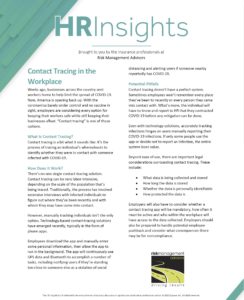Weeks ago, businesses across the country sent workers home to help limit the spread of COVID-19. Now, America is opening back up. With the coronavirus barely under control and no vaccine in sight, employers are considering every option for keeping their workers safe while still keeping their businesses afloat. “Contact tracing” is one of those options.
What Is Contact Tracing?
Contact tracing is a bit what it sounds like: It’s the process of tracing an individual’s whereabouts to identify whether they were in contact with someone infected with COVID-19.
How Does It Work?
There’s no one single contact-tracing solution. Contact tracing can be very labor-intensive, depending on the scale of the population that’s being traced. Traditionally, the process has involved extensive interviews with infected individuals to figure out where they’ve been recently and with whom they may have come into contact.
However, manually tracking individuals isn’t the only option. Technology-based contact-tracing solutions have emerged recently, typically in the form of phone apps.
Employees download the app and manually enter some personal information, then allow the app to run in the background. The app will continuously use GPS data and Bluetooth to accomplish a number of tasks, including notifying users if they’re standing too close to someone else as a violation of social distancing and alerting users if someone nearby reportedly has COVID-19.
Potential Pitfalls
Contact tracing doesn’t have a perfect system. Sometimes employees won’t remember every place they’ve been to recently or every person they came into contact with. What’s more, the individual will have to know and report to HR that they contracted COVID-19 before any mitigation can be done.
Even with technology solutions, accurately tracking infections hinges on users manually reporting their COVID-19 infections. If only some people use the app or decide not to report an infection, the entire system loses value.
Beyond ease of use, there are important legal considerations surrounding contact tracing. These include:
- What data is being collected and stored
- How long the data is stored
- Whether the data is personally identifiable
- How protected the data is
Employers will also have to consider whether a contact tracing app will be mandatory, how often it must be active and who within the workplace will have access to the data collected. Employers should also be prepared to handle potential employee pushback and consider what consequences there may be for noncompliance.
For instance, some employees may be concerned about what personal information is being collected. If they elect not to install the mandatory app, what will happen to them? Will they be fired, or will there be an alternative tracing method to use? Employers should be ready with answers to these types of questions before rolling out a contact-tracing program.
Employer Takeaway
Having some form of contact-tracing policy is important for any business reopening amid the coronavirus pandemic. If an employer elects to have a manual process, every step should be documented so everyone knows exactly how they intend to track infected employees. If opting for a digital solution, employers must consider how to enforce that all workers use it, since that’s the key to its success.
In any case, it’s good practice to have employment law counsel review any policy before implementation.
Speak with us today to discuss other ways to help keep your employees safe after reopening.
This HR Insights is not intended to be exhaustive nor should any discussion or opinions be construed as professional advice. © 2020 Zywave, Inc. All rights reserved.


